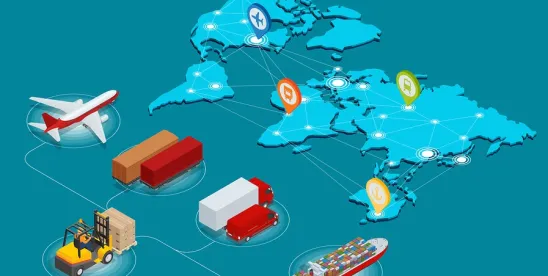Author and futurist Peter Zeihan recently asserted that President Joe Biden has presided over “the most protectionist administration the United States has had in at least a century.” And Donald Trump reportedly plans to double down on protectionism if elected in November 2024. By the way, Zeihan is also the guy who predicts that The End of the World is Just the Beginning. His theory is that the global economic and political order the United States built and maintained since WWII is collapsing.
We believe that these two trends, the increase in trade regulations and the decline of the international trading system, go hand in hand. What will this mean for global business?
1. Background: all (mostly) good things must come (slowly) to an end. Global trade is likely peaking now. According to a report by the St. Louis Federal Reserve Bank, global trade increased steadily from the 1970s to the 2000s, and plateaued “due to the rise in automation, increases in labor costs in developing countries, technology wars and the subsequent protectionist measures implemented by some governments.” This was the beginning of the end of a good thing. Although increased global trade came with major downsides, it also contributed to a healthy rise in living standards, open markets, and a period of strong global stability. Trade with low-wage countries helped make goods prices (and wages) in advanced economies lower, which strongly benefitted consumers.
Global trade had its critics. Some critiques were wrong and xenophobic; but some were correct and realistic. Comparative advantage created very complex goods at very low prices for U.S. consumers (great!). But long, complex supply lines are vulnerable to disruption (by a pandemic, for example, or a badly-timed ship maneuver) (not so great!). And free trade is not very good at protecting workers or the environment as it chases comparative advantage around the world (terrible!).
Now, the future of global trade is uncertain. The last three U.S. presidents have declined to approve judges for the World Trade Organization’s dispute settlement mechanism. A recent paper called this trend an “existential threat” to the rules-based world trading system that the United States essentially invented at the 1944 Bretton Woods conference. The United States has pulled out of numerous international trade and security agreements. In our view, this arguably depresses U.S. influence in global trade and security. More recently, doubt about some U.S. security guarantees has been growing around the world. And America’s internal difficulties with the basics of governing have been linked to a more general decline in U.S. influence abroad. And although we’re not yet buying Peter Zeihan’s conclusion that it is the end of the world order, all of this signals the possible decline of a world trading and security system that has benefited the United States and its allies since 1945.
2. More protectionism: higher walls at the borders (in and out). This waning of U.S. influence has coincided with an increase in protectionist policies in the United States and worldwide. And Economics 101 taught us that while protectionism may benefit certain protected industries in wealthy nations, it will likely slow global economic growth, slow the pace of innovation, and hinder poverty reduction efforts worldwide. One study cited in the Washington Post recently found that the Trump-era tariffs reduced U.S. wages and employment (though another study cited in the same story found that the tariffs help drive domestic investment with minimal impact on prices). The Biden administration has kept most of the Trump protectionist measures in place, and has in fact dramatically increased regulations on U.S.-China trade, particularly in high-technology areas. President Biden is continuing to actively block foreign investment in the United States, as did Presidents Trump and Obama before him. The EU has gotten serious about its own foreign direct investment restrictions. And Biden has introduced new restrictions on U.S. outbound foreign investment. And as we have reported extensively here, there are new export controls and sanctions all the time.
3. Shorter supply chains. Supply chain vulnerability has led firms to simplify their supply chains. At its extreme, this may mean onshoring all the intermediate operations to one country. Alternative approaches have been dubbed “nearshoring.” And recent remarks by U.S. Treasury Secretary Janet Yellen have urged “friendshoring.” Along similar lines, the Biden Administration has waded into the deep waters of industrial policy, with huge grants for U.S. manufacturing capacity under the CHIPS Act and the Bipartisan Infrastructure Law. We expect these efforts to expand, consistent with U.S. policy goals of “modernizing our trade relationships and supply chains to make them more resilient to global shocks,” according to the St. Louis Federal Reserve report. The desire to shorten supply chains may be a contributor to one sea change in U.S. trade: According to the New York Times, for the first time since the 90s, the United States buys more from Mexico than from China.
Taken together, we think these trends will likely raise the cost of goods in the United States as firms confront more and more obstacles to reaping the benefits of global comparative advantage. And we expect U.S. trade regulations to proliferate as the United States and its competitors abroad continue to seek ways to shape the international economy more to their liking.




 />i
/>i

